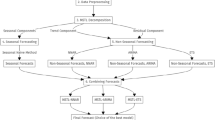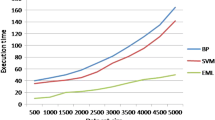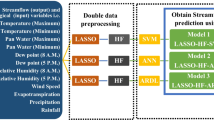Abstract
This paper presents a new prediction model based on empirical mode decomposition, feature selection and hybrid forecast engine. The whole structure of proposed model is based on nonstationarity and non-convex nature of wind power signal. The hybrid forecast engine consists of three main stages as; empirical mode decomposition, an intelligent algorithm and three stage neural network. All parameters of proposed neural network will be optimized by intelligent algorithm. Effectiveness of the proposed model is tested with real-world hourly data of wind farms in Canada, Spain and Texas. In order to demonstrate the validity of the proposed model, it is compared with several other wind speed and power forecast techniques where, different prediction horizons are considered from day-ahead to one week forecasting. Obtained results confirm the validity of the developed approach in prediction model for different forecast horizons.







Similar content being viewed by others
References
Abedinia, O., & Amjady, N. (2015). Short term load forecast of electrical power system by radial basis function neural network and new stochastic search algorithm. European Transactions on Electrical Power, https://doi.org/10.1002/etep.2160.
Abedinia, O., Amjady, N., & Ghadimi, N. (2017). Solar energy forecasting based on hybrid neural network and improved metaheuristic algorithm. Computational Intelligence. https://doi.org/10.1111/coin.12145.
Ahmadian, I., Abedinia, O., & Ghadimi, N. (2014). Fuzzy stochastic long-term model with consideration of uncertainties for deployment of distributed energy resources using interactive honey bee mating optimization. Frontiers in Energy, 8(4), 412.
Akbary, P., et al. (2017). Extracting appropriate nodal marginal prices for all types of committed reserve. Computational Economics. https://doi.org/10.1007/s10614-017-9716-2.
Alberta Energy Companies (Enmax Energy Corporation): [Online] www.enmax.com.
Bonfil, S., Guillermo, J. F.-S., Vázquez-Rodarte, I., & Vázquez-Rodarte, I. (2015). Volatility forecasting using support vector regression and a hybrid genetic algorithm. Computational Economics, 45(1), 111–133.
Ghadimi, N., et al. (2017a). Application of a new hybrid forecast engine with feature selection algorithm in a power system. International Journal of Ambient Energy. https://doi.org/10.1080/01430750.2017.1412350.
Ghadimi, N., et al. (2017b). A new prediction model based on multi-block forecast engine in smart grid. Journal of Ambient Intelligence and Humanized Computing. https://doi.org/10.1007/s12652-017-0648-4.
Ghadimi, N., & Firouz, M. H. (2015). Short-term management of hydro-power systems based on uncertainty model in electricity markets. Journal of Power Technologies, 95(4), 265.
Golbabai, A., & Saeedi, A. (2015). An improved RBF method for solving variational problems arising from dynamic economic models. Computational Economics, 46(2), 275–285.
Gollou, A. R., & Ghadimi, N. (2017). A new feature selection and hybrid forecast engine for day-ahead price forecasting of electricity markets. Journal of Intelligent & Fuzzy Systems. https://doi.org/10.3233/JIFS-152073.
Jalili, A., & Ghadimi, N. (2016). Hybrid harmony search algorithm and fuzzy mechanism for solving congestion management problem in an electricity market. Complexity, 21(S1), 90–98.
Kiani, K., & Kastens, T. (2008). Testing forecast accuracy of foreign exchange rates: Predictions from feed forward and various recurrent neural network architectures. Computational Economics, 32(4), 383–406.
Lin, W. M., Gowa, H. J., & Tsai, M. T. (2010). Electricity price forecasting using enhanced probability neural network. Energy Conversion and Management, 51(12), 2707–2714.
Liu, Y., Wang, W., & Ghadimi, N. (2017). Electricity load forecasting by an improved forecast engine for building level consumers. Energy, 139, 18–30.
Michaelides, P. G., et al. (2016). A semi-parametric non-linear neural network filter: Theory and empirical evidence. Computational Economics. https://doi.org/10.1007/s10614-016-9628-6.
Milligan, M., Schwartz, M., & Wan, Y. (2003) Statistical wind power forecasting models: Results for US wind farms, NREL-CP-500-33956, May 2003, Available [Online]: http://www.nrel.gov/docs/fy03osti/33956.pdf
Mirzapour, F., et al. (2017). A new prediction model of battery and wind-solar output in hybrid power system. Journal of Ambient Intelligence and Humanized Computing. https://doi.org/10.1007/s12652-017-0600-7.
Mohammadi, M., et al. (2017). Small-scale building load forecast based on hybrid forecast engine. Neural Processing Letters. https://doi.org/10.1007/s11063-017-9723-2.
Morsali, R., et al. (2014). A new multiobjective procedure for solving nonconvex environmental/economic power dispatch. Complexity, 20(2), 47–62.
Noruzi, A., et al. (2015). A new method for probabilistic assessments in power systems, combining monte carlo and stochastic-algebraic methods. Complexity, 21(2), 100–110.
Pedregal, J. D., & Trapero, J. R. (2007). Electricity prices forecasting by automatic dynamic harmonic regression models. Energy Conversion and Management, 48(5), 1710–1719.
Sotavento Wind Farm (2010). [Online] www.sotaventogalicia.com
Taber Wind Farm (2009). [Online] http://www.nrgstream.com.
Western Texas Wind Farm (2010). [Online] http://www.mesonet.ttu.edu/wind.html
World Wind Energy Association (2000). [Online] www.wwindea.org
Xie, L., Yingzhong, G., Zhu, X., & Genton, M. G. (2013). Short-term spatio-temporal wind power forecast in robust look-ahead power system dispatch. IEEE Transactions on Smart Grid, 5(1), 511–520.
Author information
Authors and Affiliations
Corresponding author
Rights and permissions
About this article
Cite this article
Torabi, A., Mousavy, S.A.K., Dashti, V. et al. A New Prediction Model Based on Cascade NN for Wind Power Prediction. Comput Econ 53, 1219–1243 (2019). https://doi.org/10.1007/s10614-018-9795-8
Accepted:
Published:
Issue Date:
DOI: https://doi.org/10.1007/s10614-018-9795-8




